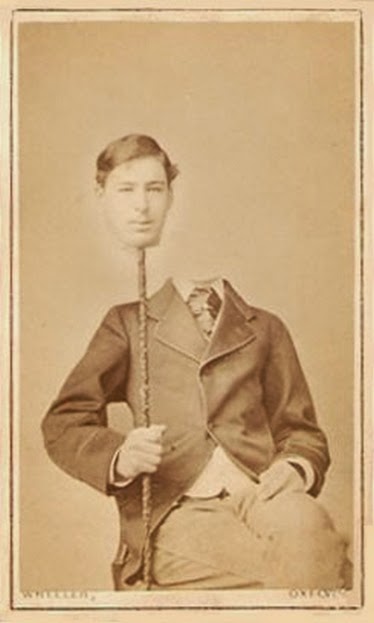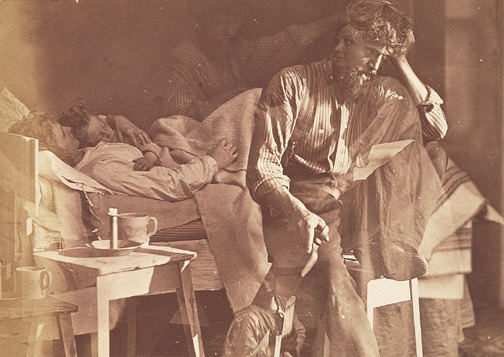|
Victorian Headless Portrait
Victorian headless portraits were a fad in Britain in the late 19th century. In the photographs, the model's head appears separated from the body; often the sitter holds it in their own hands. Although this genre is called headless portraiture, it is the head that is always present in the photograph, and the body may be absent. An early example of the genre is photographer Oscar Gustave Rejlander's ''Head of St. John the Baptist in a Charger'', a print made by combining two different negatives. The photograph dates from somewhen between 1855 and 1860. Photographer Henry Peach Robinson, described Reilander's insistence on finding a model for John the Baptist saying that "Rejlander saw his head on the shoulders of a gentleman in the town. …The curious thing is, that he did not so much see the modern gentleman as always the picture which the head suggested. It was some months before the artist ventured to ask the model to lend his head … and years before he obtained his consent ... [...More Info...] [...Related Items...] OR: [Wikipedia] [Google] [Baidu] |
William Henry Wheeler
William Henry Wheeler (1832–1915) was an English civil engineer, author, architect, inventor and antiquarian. Wheeler was born in Hammersmith in 1832. He read for a degree at King's College London, and in 1867 became a member of the Institution of Civil Engineers, from which he was the recipient of the Telford Medal. He later became a member of the British Association, The Royal Agricultural Society and the International Congress on Navigation."William Henry Wheeler" Grace's Guide to British Industrial History. Retrieved 16 January 2019William Henry Wheeler Roll of achievement, [...More Info...] [...Related Items...] OR: [Wikipedia] [Google] [Baidu] |
Rejlander St
Oscar Gustave Rejlander ( Stockholm, 19 October 1813 – Clapham, London, 18 January 1875) was a pioneering Victorian art photographer and an expert in photomontage. His collaboration with Charles Darwin on ''The Expression of the Emotions in Man and Animals'' has assured him a position in the history of behavioural science and psychiatry. Biography According to his naturalisation papers, Rejlander was born in Stockholm on 19 October 1813. He was the son of Carl Gustaf Rejlander, a stonemason and Swedish Army Officer. During his youth, his family moved to the Swedish-speaking community in Rauma, Grand Duchy of Finland (then part of Russia). In the 1830s, he relocated to England, initially settling in Lincoln, England. In the 1850s he abandoned his original profession as a painter and portrait miniaturist, apparently after seeing how well a photograph captured the fold of a sleeve. He set up as a portraitist in the industrial Midlands town of Wolverhampton, probably around ... [...More Info...] [...Related Items...] OR: [Wikipedia] [Google] [Baidu] |
Oscar Gustave Rejlander
Oscar Gustave Rejlander ( Stockholm, 19 October 1813 – Clapham, London, 18 January 1875) was a pioneering Victorian art photographer and an expert in photomontage. His collaboration with Charles Darwin on ''The Expression of the Emotions in Man and Animals'' has assured him a position in the history of behavioural science and psychiatry. Biography According to his naturalisation papers, Rejlander was born in Stockholm on 19 October 1813. He was the son of Carl Gustaf Rejlander, a stonemason and Swedish Army Officer. During his youth, his family moved to the Swedish-speaking community in Rauma, Grand Duchy of Finland (then part of Russia). In the 1830s, he relocated to England, initially settling in Lincoln, England. In the 1850s he abandoned his original profession as a painter and portrait miniaturist, apparently after seeing how well a photograph captured the fold of a sleeve. He set up as a portraitist in the industrial Midlands town of Wolverhampton, probably arou ... [...More Info...] [...Related Items...] OR: [Wikipedia] [Google] [Baidu] |
Henry Peach Robinson
Henry Peach Robinson (9 July 1830, Ludlow, Shropshire – 21 February 1901, Royal Tunbridge Wells, Kent) was an English pictorialist photographer best known for his pioneering combination printing - joining multiple negatives or prints to form a single image; an early example of photomontage. He joined vigorously in contemporary debates in the photographic press and associations about the legitimacy of 'art photography' and in particular the combining of separate images into one. Life Robinson was the oldest of four children of John Robinson, a Ludlow schoolmaster, and his wife Eliza. He was educated at Horatio Russell's academy in Ludlow until he was thirteen, when he took a year's drawing tuition with Richard Penwarne before being apprenticed to a Ludlow bookseller and printer, Richard Jones. While continuing to study art, his initial career was in bookselling, in 1850 working for the Bromsgrove bookseller Benjamin Maund, then in 1851 for the London-based Whittaker & Co. I ... [...More Info...] [...Related Items...] OR: [Wikipedia] [Google] [Baidu] |
John The Baptist
John the Baptist or , , or , ;Wetterau, Bruce. ''World history''. New York: Henry Holt and Company. 1994. syc, ܝܘܿܚܲܢܵܢ ܡܲܥܡܕ݂ܵܢܵܐ, Yoḥanān Maʿmḏānā; he, יוחנן המטביל, Yohanān HaMatbil; la, Ioannes Baptista; cop, ⲓⲱⲁⲛⲛⲏⲥ ⲡⲓⲡⲣⲟⲇⲣⲟⲙⲟⲥ or ; ar, يوحنا المعمدان; myz, ࡉࡅࡄࡀࡍࡀ ࡌࡀࡑࡁࡀࡍࡀ, Iuhana Maṣbana. The name "John" is the Anglicized form, via French, Latin and then Greek, of the Hebrew, "Yochanan", which means "God in Christianity, YHWH is gracious"., group="note" ( – ) was a mission preacher active in the area of Jordan River in the early 1st century AD. He is also known as John the Forerunner in Christianity, John the Immerser in some Baptists, Baptist Christianity, Christian traditions, and John the Baptist in Islam, Prophet Yahya in Islam. He is sometimes alternatively referred to as John the Baptiser. John is mentioned by the History of the Jews in the Roman ... [...More Info...] [...Related Items...] OR: [Wikipedia] [Google] [Baidu] |
Samuel Kay Balbirnie
Samuel ''Šəmūʾēl'', Tiberian: ''Šămūʾēl''; ar, شموئيل or صموئيل '; el, Σαμουήλ ''Samouḗl''; la, Samūēl is a figure who, in the narratives of the Hebrew Bible, plays a key role in the transition from the biblical judges to the United Kingdom of Israel under Saul, and again in the monarchy's transition from Saul to David. He is venerated as a prophet in Judaism, Christianity, and Islam. In addition to his role in the Hebrew scriptures, Samuel is mentioned in Jewish rabbinical literature, in the Christian New Testament, and in the second chapter of the Quran (although Islamic texts do not mention him by name). He is also treated in the fifth through seventh books of ''Antiquities of the Jews'', written by the Jewish scholar Josephus in the first century. He is first called "the Seer" in 1 Samuel 9:9. Biblical account Family Samuel's mother was Hannah and his father was Elkanah. Elkanah lived at Ramathaim in the district of Zuph. His genea ... [...More Info...] [...Related Items...] OR: [Wikipedia] [Google] [Baidu] |
19th-century Fads And Trends
The 19th (nineteenth) century began on 1 January 1801 ( MDCCCI), and ended on 31 December 1900 ( MCM). The 19th century was the ninth century of the 2nd millennium. The 19th century was characterized by vast social upheaval. Slavery was abolished in much of Europe and the Americas. The First Industrial Revolution, though it began in the late 18th century, expanding beyond its British homeland for the first time during this century, particularly remaking the economies and societies of the Low Countries, the Rhineland, Northern Italy, and the Northeastern United States. A few decades later, the Second Industrial Revolution led to ever more massive urbanization and much higher levels of productivity, profit, and prosperity, a pattern that continued into the 20th century. The Islamic gunpowder empires fell into decline and European imperialism brought much of South Asia, Southeast Asia, and almost all of Africa under colonial rule. It was also marked by the collapse of the lar ... [...More Info...] [...Related Items...] OR: [Wikipedia] [Google] [Baidu] |
Photography Forgeries
Photography is the art, application, and practice of creating durable images by recording light, either electronically by means of an image sensor, or chemically by means of a light-sensitive material such as photographic film. It is employed in many fields of science, manufacturing (e.g., photolithography), and business, as well as its more direct uses for art, film and video production, recreational purposes, hobby, and mass communication. Typically, a lens is used to focus the light reflected or emitted from objects into a real image on the light-sensitive surface inside a camera during a timed exposure. With an electronic image sensor, this produces an electrical charge at each pixel, which is electronically processed and stored in a digital image file for subsequent display or processing. The result with photographic emulsion is an invisible latent image, which is later chemically "developed" into a visible image, either negative or positive, depending on the purpose ... [...More Info...] [...Related Items...] OR: [Wikipedia] [Google] [Baidu] |
Photographic Techniques
Photography is the art, application, and practice of creating durable images by recording light, either electronically by means of an image sensor, or chemically by means of a light-sensitive material such as photographic film. It is employed in many fields of science, manufacturing (e.g., photolithography), and business, as well as its more direct uses for art, film and video production, recreational purposes, hobby, and mass communication. Typically, a lens is used to focus the light reflected or emitted from objects into a real image on the light-sensitive surface inside a camera during a timed exposure. With an electronic image sensor, this produces an electrical charge at each pixel, which is electronically processed and stored in a digital image file for subsequent display or processing. The result with photographic emulsion is an invisible latent image, which is later chemically "developed" into a visible image, either negative or positive, depending on the purp ... [...More Info...] [...Related Items...] OR: [Wikipedia] [Google] [Baidu] |
19th-century Portraits
The 19th (nineteenth) century began on 1 January 1801 ( MDCCCI), and ended on 31 December 1900 ( MCM). The 19th century was the ninth century of the 2nd millennium. The 19th century was characterized by vast social upheaval. Slavery was abolished in much of Europe and the Americas. The First Industrial Revolution, though it began in the late 18th century, expanding beyond its British homeland for the first time during this century, particularly remaking the economies and societies of the Low Countries, the Rhineland, Northern Italy, and the Northeastern United States. A few decades later, the Second Industrial Revolution led to ever more massive urbanization and much higher levels of productivity, profit, and prosperity, a pattern that continued into the 20th century. The Islamic gunpowder empires fell into decline and European imperialism brought much of South Asia, Southeast Asia, and almost all of Africa under colonial rule. It was also marked by the collapse of the large S ... [...More Info...] [...Related Items...] OR: [Wikipedia] [Google] [Baidu] |









